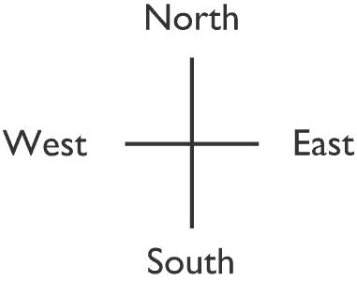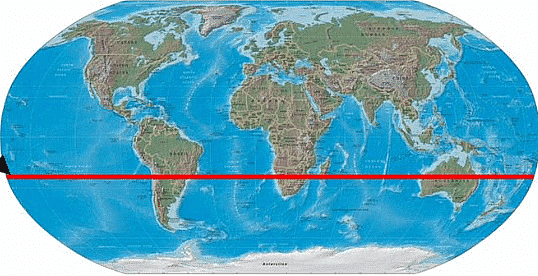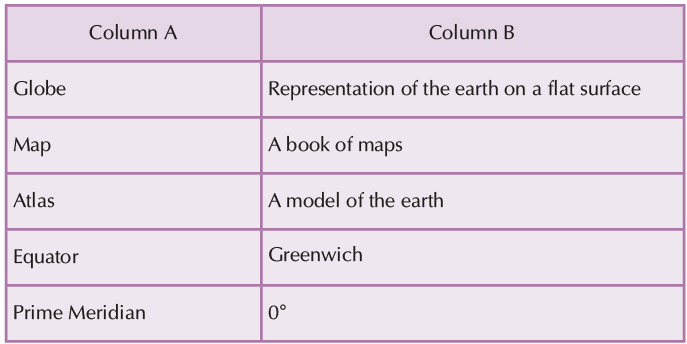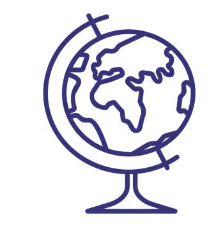Globes and Maps - 1 Class 5 Worksheet SST
Q1: Multiple Choice Questions (MCQs)
(i) North, South, East and West are four major

(a) lines
(b) signs
(c) directions
(d) none of these
Ans: (c)
North, east, south, and west are the four cardinal directions, often marked by the initials N, E, S, and W. East and west are at right angles to north and south. East is in the clockwise direction of rotation from north. West is directly opposite east.
(ii) The South Pole is
(a) 90° S
(b) 90° N
(c) 0° N
(d) none of these
Ans: (a)
The Equator is the line of 0 degrees latitude. Each parallel measures one degree north or south of the Equator, with 90 degrees north of the Equator and 90 degrees south of the Equator. The latitude of the North Pole is 90 degrees N, and the latitude of the South Pole is 90 degrees S.
(iii) The total number of meridians is
(a) 180
(b) 360
(c) 90
(d) none of these
Ans: (b)
The western most longitude is 180W and the eastern most longitude is 180E; incidentally, 180W and 180E are the same longitudes. This is called the 180th meridian and also the international date line. Therefore, the total number of latitudes is 180; and the total number of longitudes are 360.
(iv) North-east lies between
(a) South and East
(b) North and West
(c) North and East
(d) none of these
Ans: (c)
Northeast (NE), 45°, halfway between north and east.
(v) The Tropic of Cancer is located at
(a) 23½° S
(b) 23½° N
(c) 25½° W
(d) none of these
Ans: (b)
The Tropic of Cancer lies at (23.4394 degrees) north of the Equator and marks the most northerly latitude at which the sun can appear directly overhead at noon.

Q2: Fill in the blanks
(i) A globe does not give_________ information.
Ans: A globe does not give detailed or specific geographic information.
(ii) An _______ is an imaginary line on which the earth rotates.
Ans: An axis is an imaginary line on which the earth rotates.
(iii) Including the Equator there are __________ latitudes.
Ans: Including the Equator there are 181 latitudes.
(d) Signs, symbols and colours are called __________ of the map.
Ans: Signs, symbols and colours are called conventional of the map.
(iv) The imaginary lines drawn parallel to the Equator are known as parallels of _________.
Ans: The imaginary lines drawn parallel to the Equator are known as parallels of Latitudes.
Q3: Match the following
 Ans:
Ans:
- Globe - Model of earth
A globe is a spherical model of Earth, of some other celestial body, or of the celestial sphere. - Map - representation of earth on flat surface.
A map is a symbolic representation of selected characteristics of a place, usually drawn on a flat surface. - Atlas - a book of maps
An atlas is a book or collection of maps. Many atlases also contain facts and history about certain places. - Equator - 0 degree
The Equator is the invisible line that runs around the center of the Earth at 0 degrees latitude. - Prime meridian - greenwich
The prime meridian is a geographical reference line that passes through the Royal Observatory, Greenwich, in London, England.
Q4: True & False
(i) Meridians are straight vertical lines on the globe.
Ans: False
Meridians are semi-circles that extend from the North Pole to the South Pole, meeting at both poles.
(ii) The Arctic Circle is in the Southern Hemisphere.
Ans: False
The Arctic Circle is located in the Northern Hemisphere, while the Antarctic Circle is in the Southern Hemisphere.
(iii) All places on the same longitude have the same local time.
Ans: True
Since longitudes run from pole to pole, places along the same longitude experience the same local time.
(iv) The Prime Meridian is located at 0° longitude.
Ans: True
The Prime Meridian (0° longitude) is the reference line for measuring longitudes, passing through Greenwich, England.
(v) There are 180 lines of latitude in total.
Ans: False
Latitudes range from 90° North to 90° South, including the Equator (0° latitude), making a total of 181 latitudes.
Q5: Give one word answer to the following
(i) What is a book of maps called?
Ans: An atlas is a book or collection of maps. A map book is a collection of pages printed or exported together. Many of the pages contain maps, but other pages may be dedicated to text, tabular information, tables of contents, or title pages, and other content.
(ii) What is the shape of the earth?
Ans: The Earth is an irregularly shaped ellipsoid. While the Earth appears to be round when viewed from the vantage point of space, it is actually closer to an ellipsoid.
(iii) What is the ratio between the distance on the ground and the distance of the map known as?
Ans: Map scale refers to the relationship (or ratio) between distance on a map and the corresponding distance on the ground.
(iv) What is the model of an earth called?
Ans: Maps and globes are models of the Earth's surface. Globes are the most accurate representations because they are spherical like the Earth. We cannot see the Earth all of it at once as it is so large. So, globe helps us to see what the whole Earth looks like. A globe is better representation of earth in comparison to a flat map.
Q6: Short answer type questions
(i) Which are the four major directions?
Ans: North, east, south, and west are the four cardinal directions, often marked by the initials N, E, S, and W. East and west are at right angles to north and south.
(ii) Which are the important latitudes?
Ans: The five major circles of latitude are, starting from the North Pole and finishing at the South Pole; the Arctic Circle, the Tropic of Cancer, the Equator, the Tropic of Capricorn and the Antarctic Circle.
(iii) What is the main feature of a map?
Ans: Some common features of maps include scale, symbols, and grids. All maps are scale models of reality. A map's scale indicates the relationship between the distances on the map and the actual distances on Earth.
Q7: Long answer type questions
(i) Write the features and limitations of a globe.
Ans: A globe is a spherical model of Earth, of some other celestial body, or of the celestial sphere. Globes serve purposes similar to some maps, but unlike maps, do not distort the surface that they portray except to scale it down. A model globe of Earth is called a terrestrial globe.
The limitations of a globe are:
- A globe cannot give the correct idea of the distances between two places.
- A globe is too small to get the actual size of an area.
- The types of terrain and landscape of a place cannot really be figured on a globe

(ii) What do you mean by Northern Hemisphere and Southern Hemisphere?
Ans: It runs east and west around Earth's middle. Places north of the equator are part of the Northern Hemisphere. Places south of the equator are in the Southern Hemisphere. The Northern Hemisphere includes North America, Central America, Europe, and mainland Asia.
(iii) Write short notes on:
(a) Longitude
Ans: Longitude is the measurement east or west of the prime meridian. Longitude is measured by imaginary lines that run around the Earth vertically (up and down) and meet at the North and South Poles. These lines are known as meridians.
(b) Eastern and Western Hemispheres
Ans: The Western Hemisphere is a geographical term for the half of Earth which lies west of the prime meridian (which crosses Greenwich, London, United Kingdom) and east of the antimeridian. The other half is called the Eastern Hemisphere.
(c) International Date Line
Ans: The International Date Line, established in 1884, passes through the mid-Pacific Ocean and roughly follows a 180 degrees longitude north-south line on the Earth. It is located halfway round the world from the prime meridian—the zero degrees longitude established in Greenwich, England.
|
33 videos|264 docs|50 tests
|
FAQs on Globes and Maps - 1 Class 5 Worksheet SST
| 1. What is the difference between a globe and a map? |  |
| 2. How are globes and maps used differently in education? |  |
| 3. Are there any advantages to using a globe over a map? |  |
| 4. Can globes and maps be used interchangeably in all situations? |  |
| 5. How can globes and maps be used together effectively in learning environments? |  |






















